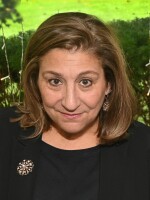At St. Mark Child and Family Development Center, part of United Innter City Services at 12th and Garfield in Kansas City, Missouri, toddlers are coming back in phases.
Several slept soundly on a recent rainy afternoon, their cots spread a safe six feet apart, according to COVID-19 social distancing rules.
"We were crammed having 20 cots three feet apart," says United Inner City Services CEO Deidre Anderson. "Now, with the six foot requirement, we're having to look at additional space."
Social distancing, masks, increased sanitizing and virtual learning, accomodations all public spaces are putting place, create a specific set of challenges for child care facilities. In Missouri, almost 40 percent will stay closed as other businesses reopen. On the Kansas side, where there are more programs, more than 10 percent will not reopen.
Anderson says she's already seeing how the new landscape can feel chaotic to kids, even with just a fraction of their enrollment back.
"The uncertainty we feel as adults, kids carry it in their body," she says. " There have been a lot more kids just running the halls, just a little bit out of sorts."

There are other changes: parents won't bring their children into the classroom in the morning or to fetch them in the afternoon. As a family center, Anderson says this is a complete about-face from earlier practices, and something they will likely continue into the foreseeable future.
Everyone will get a temperature check and wear a mask.
All the families have had virtual classroom activities and access to teachers since the center shut down. Anderson says for any family that isn't comfortable coming back, they'll continue to be available online.
"If a parent says I want to enroll with you but I want to have two days a week in the center versus five days a week, and on those other days I want do virtual lessons, that's OK! This may be the next normal for a very long time."
And that normal, she says, will vary from child to child. Some will miss the hugs and high-fives they get from teachers every day. Others won't miss a beat as long as the songs and reading of books continues online. But the virtual classroom could be entirely different for the ninth grader who is less inclined to engage remotely with instructors.

Operation Breakthrough at 31st and Troost recently announced that the nearby DeLaSalle Charter School was donating the use of its building, allowing the center to take an additional 200 children this summer. To help out with the new classes, the center is in the process of hiring 45 new staff to fill the short term need.
Esselman says Operation Breakthrough was able to remain open throughout the pandemic, except for a few days. She says even for that short period, there were some parents who were desperate to find care for their young children while they had not choice but to return to work.
"They had to stay home,"she says. "We always try to provide a letter, or a phone call. In these cases, I got on the phone with the supervisor to say yes, there was not going to be child care for that week."
Luckily, it worked. No one lost a job.
Impact on teachers
While the environment for children and parents has changed, it's also changed for teachers.
Mike English, executive director of Turn the Page KC, says some of those changes might drive educators away. Some may find virtual teaching too complicated. Others may feel the mask robs them of a personal connection, the ability to convey a smile, displeasure or surprise.
“I’m afraid that we’re going to see more and more teachers deciding to retire early or take a hiatus from the teaching profession when we need them the most," he says.
Of course, no one really knows what to expect on the other side of this summer’s child care crisis, or what it will mean for educators in the fall. We won’t know for weeks, maybe months how lifting stay-at-home orders will affect infection rates.
Paula Neth of the Family Conservancy says amidst all the uncertainty, there will be a critical need to watch it's impact on our children and youth.
"As adults we’re having a hard time trying to understand what all this means and adapt to what I call un-normal, this new normal." she says. "So keeping our eye on that and insuring that social distancing doesn’t mean emotional distancing.





